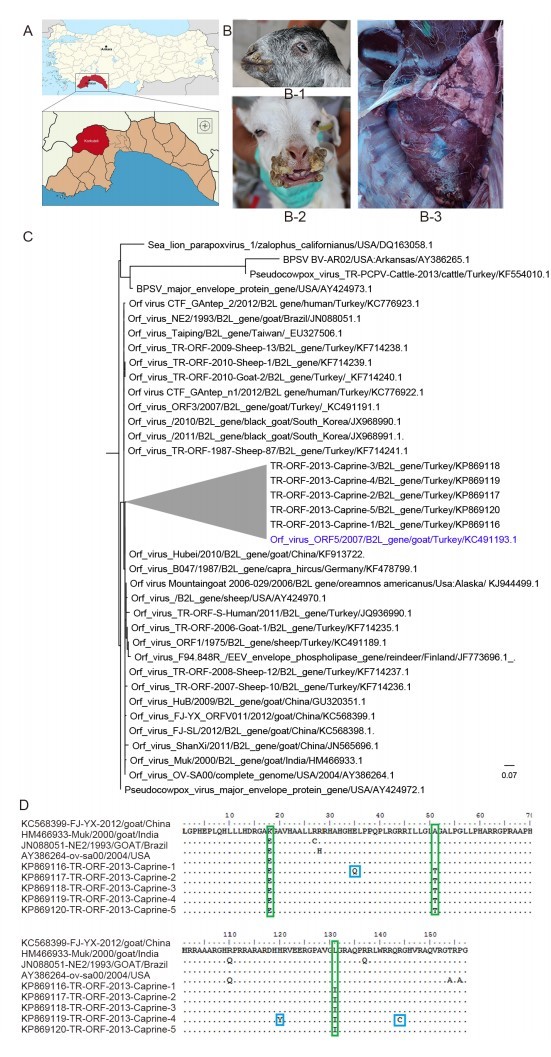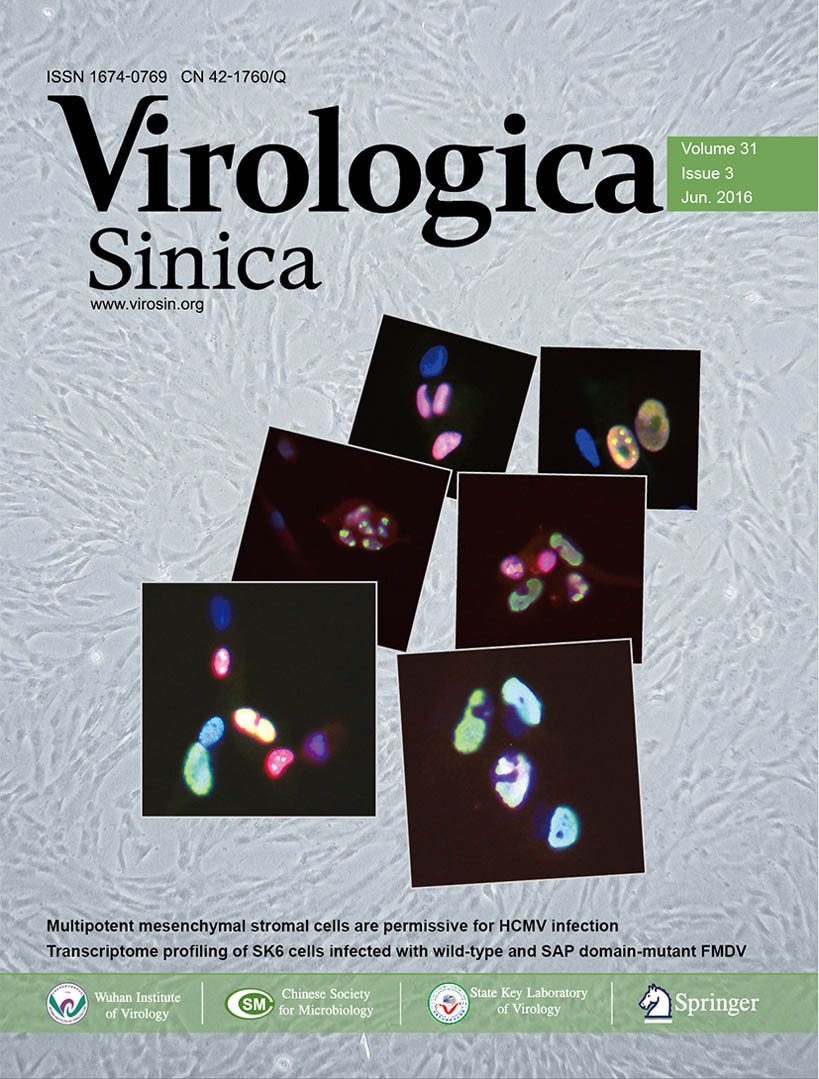-
Dear Editor,
The Poxviridae family is divided into Chordopoxvirinae and Entomopoxvirinae genera. Parapoxvirus is one of 11 genera in the Chordopoxvirinae genus, including orf virus (ORFV), bovine papular stomatitis virus (BPSV), pseudocowpox virus (PCPV) and parapoxvirus of red deer in New Zealand (PVNZ) (Skinner et al., 2012). This virus, also known as contagious ecthyma or contagious pustular dermatitis, is a viral skin disease causing edematous proliferative lesions, most often in hairless skin regions around the muzzle and buccal cavity. Several molecular diagnostic methods including polymerase chain reaction (PCR) and quantitative PCR (qPCR) have been developed to detect orf virus (Gallina et al., 2006). In this study, multiplex PCR was used to amplify both the B2L gene partial coding region and a housekeeping gene. A substantial amount of research has been conducted on the B2L gene, and this presents opportunities for comparisons between different strains around the world. Field strains have been compared with human, sheep, and goat orf viruses and with other parapoxviruses such as PCPV and BPSV. Although the presence of the virus in Turkey was previously reported, its relationship with other orf viruses around the world has not yet been demonstrated, in contrast to parapoxvirus infections of cattle and humans in Turkey (Karakas et al., 2013; Oğuzoğlu et al., 2014). This study provides diagnostic and molecular characterization data for the economically damaging parapoxvirus infection that circulated among goat flocks in Turkey in the 2013-2014 lambing season.
Scab samples were taken from five affected lambs (aged 5-60 days) from a private goat herd reared from Aleppo and Saanen goats in Korkuteli, Antalya (South Anatolia), Turkey (Figure 1A). The herd was one-third Aleppo and two-thirds Saanen goats. The herd with pregnant goats comprised approximately 1, 700 goats that were not pasturing outside the farm. The lambs, which had been vaccinated against orf virus before the outbreak, had facial and oral lesions, with papillomatous proliferative lesions especially around the upper and lower labia (Figure 1B-1, 1B-2). There were also diffuse nodular lesions in the lungs (Figure 1B-3). The farm had 750 lactating female goats and 475 newborns, of which 38 died during the outbreak.

Figure 1. (A) Samples collected from Antalya city, Korkuteli county, South Anatolia, Turkey in 2013-2014. (B-1, B-2) Kids showing multiple proliferative lesions on the upper and lower labia and the junction of lips. (B-3) Lung of a kid with nodules. (C) Phylogenic analysis of local goat orf viruses based on partial B2L protein coding sequences. The sequences obtained were aligned using CLC Main Workbench v5.5 (CLCBio, Aarhus, Denmark), and analyzed with Mega 6.06 (Tamura et al., 2013). The Maximum-Likelihood trees were generated based on the Hasegawa-Kishino-Yano model with 1, 000 bootstrap replicates. Virus strains represented are indicated by name following GenBank accession number. Sea lion parapoxvirus, pseudocowpox viruses and bovine papular stomatitis viruses are included as an outlier. All sequences were compared against nucleotide numbers 11, 053-11, 557 of their complete genome. (D) Multiple alignment of the deduced amino acid sequences of B2L genes of Turkish goat orf strains with those of orf strains from various countries. Dots denote amino acid identity with a goat orf virus from China (KC568399).
Scab materials were homogenized in phosphate-buffered saline (PBS), frozen and thawed for three cycles, and centrifuged at 4000 rpm/min for 15 minutes. The resulting supernatant was used for total DNA extraction by the phenol:chloroform:isoamylalcohol extraction method described by Sambrook et al. (2001). PCR was performed using a modification of the method of Inoshima et al. (2000), using primers PPP-1 (5′-GTCGTCCAC-GATGAGCAGCT-3′) and PPP-4 (5′-TACGTGGGAAGCGCCTCGCT-3′) specific for the parapoxvirus virus B2L gene (Inoshima et al., 2000). Internal control primers were used in the same reaction, as described by Markoulatos et al. (2000), for verification of the reaction, which was carried out in a total volume of 30 μL of mix containing (5 U/μL) Taq DNA polymerase (MBI, Fermentas, Waltham, MA, USA), 10 × Taq Buffer (1.25 mL including (NH4)2SO4, 25 mmol/L MgCl2, and water (18 Mohm/cm, Applichem, Darmstadt, Germany)), primers, and 3 μL of extracted DNA. An initial denaturation step at 96℃ for 5 min was followed by 35 cycles of DNA denaturation at 96℃ for 30 s, primer annealing at 48℃ for 30 s, and an amplification step at 72℃ for 45 s. PCR products (595 bp) were purified with a Gene JET PCR purification Kit (Thermo Scientific, Waltham, MA, USA), and PCR fragments were sent to RefGen (Ankara, Turkey) for Sanger sequencing. BLAST searches in GenBank revealed these sequences to be 98%-99% identical to various orf virus strains, and they were submitted to the NCBI GenBank database and assigned the accession numbers KP869116-KP869120. Homology analyses showed that all five strains cluster together, with similar nucleotide variation. Among the five sequences, TR-ORF-2013-Caprine 2, 3, 4, and 5 shared 100% nucleotide identities, and TR-ORF-2013-Caprine-1 showed a 0.8% nucleotide difference from the other four field strains. All five strains showed only a 0.8% difference from the KC491193.1 goat orf virus strain detected in 2007 in Turkey (Figure 1C).
BPSV Arkansas USA (AY386265.1), BPSV USA (AY424973.1), sea lion parapoxvirus USA (DQ163058.1), pseudocowpox virus Turkey (KF554010.1), and pseudocowpox virus USA (AY424972.1) were used as outlier strains. These parapoxviruses were found to be distantly related to goat and sheep orf viruses, except for the pseudocowpox virus USA strain, which was closely related to our field strains, with 99.5% sequence homology. The Turkish pseudocowpox virus showed a large distance from our field strains, with a 100 bootstrap value and 84.9% sequence identity. Strain Hubei/2010/goat/China/KF913722, FJSL/2012/goat/China/KC568398.1, and B047/1987/capra_hircus/Germany/KF478799.1 sequences were strongly similar to our five field strains, with 99.84% identity.
TR-ORF-1987-Sheep-87/B2L gene/Turkey/KF714241.1, and TR-ORF-2009-Sheep-13/B2L gene/Turkey/KF714238.1 shared 99.84% identity at the nucleotide level with four of the strains characterized in this study, with TR-ORF-2013-Caprine 1 being the only exception. They also displayed 99.76% similarity with TR-ORF-2013-Caprine 1. TR-ORF-2008-Sheep-12/B2L gene/Turkey/KF714237.1 showed 99.92% and 99.84% identity with TR-ORF-2013-Caprine 2, 3, 4, and 5, and TR-ORF-2013-Caprine 1, respectively. TR-ORF-2010-Goat-2/B2L gene/Turkey/KF714240.1, TR-ORF-2010-Goat-2/B2L gene/Turkey/KF714240.1, and TR-ORF-2007-Sheep-10/B2L gene/Turkey/KF714236.1 strains exhibited 99.76% and 99.68% identity with TR-ORF-2013-Caprine 2, 3, 4, and 5 and TR-ORF-2013-Caprine 1, respectively.
CTF_GAntep_n1/2012/B2L gene/human/Turkey/KC776922.1 showed 99.84 and 99.76% identity with TR-ORF-2013-Caprine 2, 3, 4, and 5, and TR-ORF-2013-Caprine 1, respectively. CTF_GAntep_2/2012/B2L gene/human/Turkey/KC776923.1, which displayed 99.76% and 99.67% identity with TR-ORF-2013-Caprine 2, 3, 4, and 5, and TR-ORF-2013-Caprine 1, respectively, showed a greater similarity to these strains than TR-ORF-S-Human/2011/B2L gene/Turkey/JQ936990.1, which had 99.51% and 99.60% identity with TR-ORF-2013-Caprine 2, 3, 4, and 5, and TR-ORF-2013-Caprine 1, respectively.
The other strains from different geographical regions (China's Taiwan, South Korea, China, India, and USA) also demonstrated 99.67%-99.84% identity globally. Finally, EEV envelope phospholipase gene/reindeer/Finland/JF773696.1 had 99.68% similarity with all five strains characterized in this study.
Amino acid (aa) sequence comparisons between the Turkish goat orf strains and the selected reference orf strains showed that they were nearly identical but contained a few changes (Figure 1D). Like other reference orf strains, the Lysine (K) at position 18 of the aa sequence in all the Turkish strains was changed to Glutamic acid (E). The Alanine (A) at position 51 was changed to Threonine (T), and the Leucine (L) at position 131 was changed to Threonine (T) concurrently in all Turkish goat orf strains. Some other individual aa changes were observed in TR-ORF-1 and TR-ORF-4. In TR-ORF-1; the Glutamic acid, (E) at position 35 of the aa sequence was changed to Glutamine (Q). In TR-ORF-4, the Histidine (H) at position 120 was changed to Tyrosine (Y), and Arginine (R) at position 144 was changed to Cysteine (C).
Animal husbandry in Turkey includes 10 million goats, constituting 2.5% of total milk production. In recent years, Aleppo and Saanen goats have been increasingly exported to Turkey for milk production. However, importing animals increases the risk of exposure associated with infectious agents such as orf virus, which can lead to outbreaks in goats and associated economic damage. Orf virus infection has a worldwide distribution (Fleming et al., 2007, Kumar et al., 2014) and causes the formation of lesions around the mouth and nostrils so that animals are unable to graze and become weak (Mazur et al., 1989). The disease mainly infects lambs younger than 1 year. Viral circulation happens very rapidly through direct contact or scab shedding (Fleming et al., 2007). Orf virus can also cause mortality in young animals, although the rate is lower than the incidence of the disease, which can reach 90% (Mazur et al., 1989; Fleming et al., 2007). Mortality is either due to secondary bacterial and fungal infections or because the lambs are unable to suckle (Haig et al., 2002). In the present outbreak, the kid fatality rate was 8% (38/475). Few investigations have focused on Turkish goat orf viruses (Oguzoglu et al., 2009). The present study illustrates the relationship of Turkish goat orf viruses with other orf and parapoxviruses around the world. All five strains shared 99.92% identity at the nucleotide level with KC491193.1. Few amino acid changes were seen in the B2L gene between Turkish goat orf strains from the same herd and orf strains from different countries (Figure 1-D). However, this strain was localized in a separate branch on the phylogenetic tree. The phylogenetic analysis results, which also included sequence data from several years in Turkey (1975, 1987, 2006, 2007, 2008, 2009, and 2010), showed that these orf virus outbreaks are closely related antigenically. Moreover, homology-based phylogenetic analysis showed that the goat orf virus B2L gene partial coding region encoding the major envelope protein p42K is not only similar to that of goat orf viruses but also to that of sheep, deer, human, and cow parapoxviruses (Sullivan et al., 1994). This indicates that orf virus infection is endemic in small ruminants in Turkey, with continuous risk of human transmission. The phylogenetic characterization among parapoxvirus strains indicates that the B2L region is a highly conserved region in orf viruses. As has already been carried out by some researchers, future studies can employ different open reading frames (ORFs) to detect variable regions in the virus genome (Peralta et al., 2015). Appropriate vaccination programs and sanitation measures would both decrease economic losses and reduce the risk of human infection.
HTML
-
We thank veterinary surgeon Osman Talayman for his help sampling scab materials from lambs. This study did not receive any funding. All institutional and national guidelines for the care and use of animals were followed. The authors declare that there are no conflicts of interests.














 DownLoad:
DownLoad: